Tag Archive: strategy
June 16, 2014
by Carole Zangari -
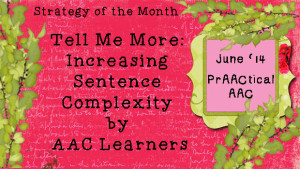
Expanding the length and complexity of sentences is something that SLPs love to work on well beyond the ‘early communicator’ phase, something we talked about a few weeks back. In today’s post, we’ll consider ways to build more complex utterances for learners who are gaining competence with their AAC systems but who still use language that is immature, imprecise, or overly simplistic. In many ways, this therapy is like language therapy for any other learner with delays in grammar, syntax, and morphology. Indeed, we sometimes forget to activate all that we know about language intervention when working learners who use AAC. We try to use that as a starting point and adjust for the AAC components as needed. Here are some of the things that we think about when planning therapy for AAC learners who are trying to strengthen their ability to speak in more complex sentences. Relate the language... [Read More...]
Filed under: Strategy of the Month
Tagged With: intervention, language intervention, sentence length, strategy
May 19, 2014
by Carole Zangari -
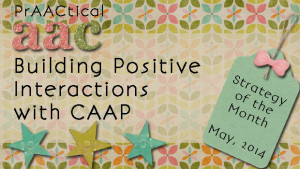
One of the challenges in helping AAC learners maximize their communicative potential is that they often interact with people who do not facilitate positive interactions. We know, for example, that partners may focus on the SGD rather than the topic or communicator (e.g., “Can you find ‘go?’, “Press it again”). They may dominate the conversation by taking more than their fair share of turns, making for a lop-sided and uninteresting context that is more of a monologue than a true conversation. They also tend to interrupt the AAC learner, often in an attempt to guess the learner’s message, save time, or correct the person. These actions come from a good place (wanting to support the learner) but are not things that facilitate improved communication. In a previous post, we talked about the RAAP strategy, for building partner skills during storybook reading. In this post, we continue to share the work of... [Read More...]
Filed under: Strategy of the Month
Tagged With: CAAP, Cathy Binger, Jennifer Kent-Walsh, strategy
May 4, 2013
by Carole Zangari -
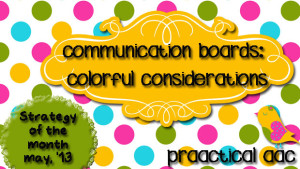
We love AAC technology and are deeply grateful for the options that are available to people with significant communication difficulties. We’re strong supporters of voice output systems and the autonomy they give to the children and adults with whom we work. On the other hand, we have great respect and much fondness for the “no tech” communication aids and visual supports. As a student clinician, I made my first conversation book for Sherri, a young lady who had learned Bliss at school but had no communication materials in the institution where she was living. In my days as a clinical fellow, I got ratted out by Davey, a client who used his 100-location Bliss board to tell the supervisor that I gave out seconds on coffee even though the rule was one cup per person. (I knew I should never have taught him interjections!) There’s no doubt – communication boards... [Read More...]
Filed under: Strategy of the Month
Tagged With: color, color coding, communication book, Crain, Elder, Fitzgerald Key, Goossens', no tech, strategy
March 2, 2013
by Carole Zangari -
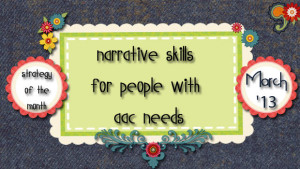
This month, we’ll share some thoughts about helping people with AAC needs develop narrative skills. Why narrative skills? Because they help us connect to one another and communication learning works best when we feel connected. Among other things, storytelling helps us relate to one another. Narrative language is important for reading and writing skills to develop. It helps us understand the world and ourselves. In telling our stories, we establish our identities. Plus, it’s part of what makes life fun. In the US, pediatric therapists are having lots of conversations about the Common Core State Standards (CCSS) in English Language Arts (ELA), and how they relate to the IEP goals of the students that they serve. Many of the goals in the ELA speaking domain require students to be able to summarize what they hear and read, so it is no surprise that SLPs are prioritizing narrative language and related... [Read More...]
Filed under: Strategy of the Month
Tagged With: langage development, narrative language, storytelling, strategy
February 2, 2013
by Carole Zangari -
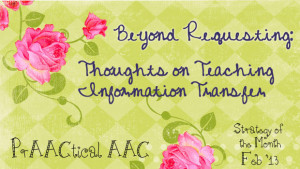
Although it has been close to 25 years since Dr. Janice Light’s hallmark paper on communicative competence in AAC discussed four main purposes of communication, many AAC systems are still heavily populated with messages for basic wants and needs. The other areas – information transfer, social closeness, social etiquette – are often underrepresented in AAC systems. We scratched the surface of how to teach basic requesting last month, and now we’re ready to talk about communicating for other reasons. In this post, we’ll talk about some of the clinical issues in teaching communication for the purpose of information transfer. A big reason that we express ourselves is to share information that others want or need. It may not seem like a high priority until we realize how often we need to do this to function in our daily lives. Here are some examples, both positive and negative, from our work... [Read More...]
Filed under: Strategy of the Month
Tagged With: AAC goals, communicative competence, information transfer, language intervention, strategy
November 3, 2012
by Carole Zangari -
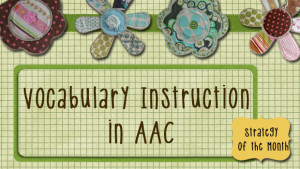
For all of us, the process of how we learn to use words begins with the expression of our own intents. Initially, we use words, pictures, or signs to make our wants/needs known but that soon develops into social exchanges, true conversations, stories, and more. For some of our AAC friends, the path to a rich lexicon can be convoluted and bumpy. Our November Strategy of the Month posts will focus on vocabulary instruction giving both general principles that should guide our teaching and specific considerations for communicators at different levels. As SLPs, we should be champions for a comprehensive approach to semantic instruction in AAC. Much of what we already know for teaching semantics to people who speak can be applied quite nicely to individuals with AAC needs. Certainly some things will need to be adapted, but that’s not the real issue. We’ve noticed that SLPs sometimes forget to... [Read More...]
Filed under: Strategy of the Month
Tagged With: intervention, new words, semantics, strategy, vocabulary, word learning





